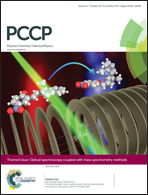Six-fold-symmetry internal rotation in toluenes: the low barrier challenge of 2,6- and 3,5-difluorotoluene†
Abstract
Pure six-fold symmetry (V6) internal rotation poses significant challenges to experimental and theoretical determination, as the very low torsional barriers result in huge tunneling splittings difficult to identify and to model. Here we resolved the methyl group internal rotation dynamics of 2,6- and 3,5-difluorotoluene using a newly developed computer code especially adapted to V6 problems. The jet-cooled rotational spectra of the title molecules in the 5–25 GHz region revealed internal rotation tunneling doublings of up to 3.6 GHz, which translated in methyl group potential barriers of V6 = 0.14872(24) and 0.0856(10) kJ mol−1, respectively, in the vibrational ground-state. Additional information on Stark effects and carbon isotopic species in natural abundance provided structural data and the electric dipole moments for both molecules. Ab initio calculations at the MP2 level do not reproduce the tiny torsional barriers, calling for experiments on other systems and additional theoretical models.


 Please wait while we load your content...
Please wait while we load your content...